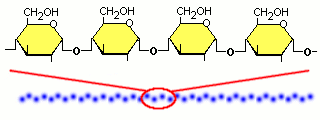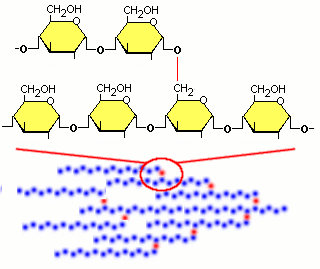VIVO Pathophysiology
Dietary Polysaccharides
Polysaccharides, particularly of plant origin, are prominent components in the diets are herbivores and omnivores. This complex set of molecules has been categorized in several ways, depending on whether the focus is chemistry or nutrition. From the standpoint of digestive physiology and nutrition, perhaps the most relevant classification is based on whether or not animals synthesize enzymes that allow the polysaccharide in question to be digested into absorbable monosaccharides. In this view, we have starch, which can be digested by vertebrate enzymes, versus fiber, which cannot.
Starch: Amylose and Amylopectin
Starch is the principle carbohydrate found in plant seeds and tubers; important sources of starch include maize (corn), potato and rice. Starch exists in the form of granules, each of which consist of several million amylopectin molecules together with an even larger number of amylose molecules. Since amylopectin is a much larger molecule than amylose, the mass of amylopectin is typically 4 to 5 times that of amylose in starch.
| Amylose consists of a linear, helical chains of roughly 500 to 20,000 alpha-D-glucose monomers linked together through alpha (1-4) glycosidic bonds. |  | Amylopectin molecules are huge, branched polymers of glucose, each containing between one and two million residues. In contract to amylose, amylopectin is branched. It contains numerous amylose-like chains of up to 30 glucose residues linked through alpha (1-4) bonds, connected to one another through alpha (1-6) branch points. |  |
Starch is digested to glucose in two basic steps:
First amylose and amylopectin are hydrolyzed into small fragments through the action of alpha-amylase, secreted by salivary glands in some species, and from the pancreas in all. Amylase cleaves only internal alpha (1-4) glycosidic bonds, thereby reducing starch to three different oligosaccharides: maltose (disaccharide), maltotriose (trisaccharide), and a group of alpha-limit dextrins which contain branch points from amylopectin.

Second, maltose, maltotriose and limit dextrins are hydrolyzed on the lumenal surface of the small intestine by a brush border enzyme complex called sucrase-isomaltase (also often referred to as maltase). This step ultimately yields glucose monomers that are then transported into the small intestinal enterocyte by co-transport with sodium ions.
Dietary Fiber: Cellulose and Hemicellulose
Several definitions have been proposed for "fiber". An early definition, still quite appropriate, basically states that fiber is the portion of food derived from plant cell walls that is poorly digested by mammals." To put it another way, mammals often consume fiber, but do not themselves secrete the enzymes necessary to digest it into a form that can be absorbed. Another common definition for fiber is the non-starch polysaccharide component of foodstuffs.
The chief components of dietary fiber are cellulose and hemicellulose, both of plant origin. Pectin and pectic acid are other plant polysaccharides often present in diets.
Cellulose is a linear polymer of between 1000 and 10,000 beta-D-glucose molecules in which adjacent glucose molecules are joined covalently through beta (1-4) glycosidic bonds. The beta (1-4) bonds cause the polymer to assume a non-helical, straight structure, which is different from the helical structure imposed on starch molecules by the alpha (1-4) bonding. The non-helical structure of cellulose also promotes hydrogen bonding between cellulose molecules.
Cellulose polymers associate with one another through a huge number of hydrogen bonds to form microfibers. Microfibers interact to form cellulose fibers. A typical fiber contains roughly 500,000 cellulose molecules. The high tensile strength of cellulose fibers reflects the massive number of hydrogen bonds involved in its structure.
Hemicellulose is a heteropolymer composed of a variety of sugars, including xylose, arabinose and mannose in a branched structure. In contrast to the highly ordered structure of cellulose, hemicellulose assumes an amorphose structure and becomes highly hydrated to form a gel.
No vertebrate cell has been identified that produces an enzyme that hydrolyzes celluloses or hemicelluloses. Certainly, amylase will not cleave these two polysaccharides. Dietary fiber therefore is indigestable and passes through the small intestine essentially unchanged.
Within the large intestine (or the forestomaches of ruminants), fiber is digested by enzymes - cellulases and hemecellulases - of microbial origin, a process refered to as fermentation. Fermentation does not yield monosaccharides that can be absorbed. Rather, its chief products are short chain volatile fatty acids, which are readily absorbed and utilized for energy and lipid synthesis. Thus, if the fermentation vat is of sufficient size (i.e. herbivores), dietary fiber can be a major source of energy. 11
Send comments to Richard.Bowen@colostate.edu
